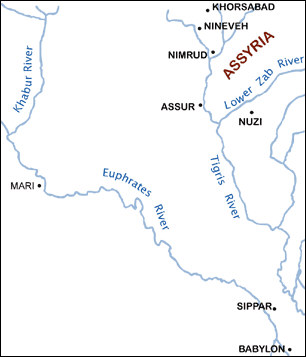Map of Assyria
![]()
Map of the Major Cities of Assyria in the Ancient Near East

About the time of King David and Solomon the Assyrians began to move northward and westward in their military expansions. They were searching for booty such as metals like gold, iron and bronze, and horses. Under King Ashurnasirpal II (885-860 BC) the Assyrian capital was moved to Nimrud (Kalhu) and the next set of kings expanded the kingdom of Assyria to beyond the Euphrates River Euphrates. When Tiglath-Pileser III came to power in 747 BC, he conquered nations to form an empire and deported the people of those nations throughout the Assyrian Empire. For the next 100 years the Assyrian kings build new capitals: Sargon built his palace at Khorsabad, and Sennacherib built Nineveh and Esarhaddon not only expanded these new capitals but expanded the empire until Assyrian dominance reached from Persia to the Mediterranean Sea. Ashurbanipal (668-626 BC) fought many wars with Egypt, and Babylonia and Elam were crushed. In 616 BC the new king of Babylon, Nabopolassar joined with the Medes and attacked Assyria. The mighty Empire of Assyria finally fell in 612 BC and Nineveh was destroyed. The Assyrian royalty fled to the city of Haran and the Babylonians came and destroyed them in 609 BC.
Assyria on the Northern Tigris River
See Map of the Fertile Crescent
See Map of Israel
See Map of Assyria
The kings of later Assyria reigned from the 9th century BC until the fall of Assyria in 612 BC.
Later kings of Assyria (885-607 B.C.)
Assur-nasirpal II (885-860 B.C.)
Shalmaneser II (860-825 B.C.)
Shansi-adad (825-808 B.C.)
Adad-nirari (808-783 B.C.)
Shalmaneser III (783-771 B.C.)
Assur-dayan (771-753 B.C.)
Assur-lush (753-747 B.C.)
Tiglath-pileser III (Pul) (747-727 B.C.)
Shalmaneser IV (727-722 B.C.)
Sargon II (722-705 B.C.)
Sennacherib (705-681 B.C.)
Esar-haddon (681-668 B.C.)
Assur-banipal (668-626 B.C.)
Assur-etil-ilani (626-607 B.C.)
Assyrian annals mention contacts with some nine Hebrew kings: Omri, Ahab, Jehu, Menahem, Pekah, Uzziah, Ahaz, Hezekiah, and Manasseh.
In the reign of Hoshea, king of Israel, Shalmaneser, king of Assyria, twice invaded (2 Kings 17:3,5) the kingdom that remained, and his successor Sargon II took Samaria in 722 BC, carrying away 27,290 of the population as he tells in his Khorsabad Annals. Later Assyrian kings, notably Esarhaddon (681 BC - 668 BC), completed the task.
![]()
Read The Bible
- 1599 Geneva Bible (GNV)
- 21st Century King James Version (KJ21)
- American Standard Version (ASV)
- Amplified Bible (AMP)
- Amplified Bible, Classic Edition (AMPC)
- Authorized (King James) Version (AKJV)
- BRG Bible (BRG)
- Christian Standard Bible (CSB)
- Common English Bible (CEB)
- Complete Jewish Bible (CJB)
- Contemporary English Version (CEV)
- Darby Translation (DARBY)
- Disciples’ Literal New Testament (DLNT)
- Douay-Rheims 1899 American Edition (DRA)
- Easy-to-Read Version (ERV)
- English Standard Version (ESV)
- English Standard Version Anglicised (ESVUK)
- Evangelical Heritage Version (EHV)
- Expanded Bible (EXB)
- GOD’S WORD Translation (GW)
- Good News Translation (GNT)
- Holman Christian Standard Bible (HCSB)
- International Children’s Bible (ICB)
- International Standard Version (ISV)
- J.B. Phillips New Testament (PHILLIPS)
- Jubilee Bible 2000 (JUB)
- King James Version (KJV)
- Lexham English Bible (LEB)
- Living Bible (TLB)
- Modern English Version (MEV)
- Mounce Reverse Interlinear New Testament (MOUNCE)
- Names of God Bible (NOG)
- New American Bible (Revised Edition) (NABRE)
- New American Standard Bible (NASB)
- New American Standard Bible 1995 (NASB1995)
- New Catholic Bible (NCB)
- New Century Version (NCV)
- New English Translation (NET)
- New International Reader's Version (NIRV)
- New International Version - UK (NIVUK)
- New International Version (NIV)
- New King James Version (NKJV)
- New Life Version (NLV)
- New Living Translation (NLT)
- New Matthew Bible (NMB)
- New Revised Standard Version (NRSV)
- New Revised Standard Version Catholic Edition (NRSVCE)
- New Revised Standard Version, Anglicised (NRSVA)
- New Revised Standard Version, Anglicised Catholic Edition (NRSVACE)
- New Testament for Everyone (NTE)
- Orthodox Jewish Bible (OJB)
- Revised Geneva Translation (RGT)
- Revised Standard Version (RSV)
- Revised Standard Version Catholic Edition (RSVCE)
- The Message (MSG)
- The Voice (VOICE)
- Tree of Life Version (TLV)
- World English Bible (WEB)
- Worldwide English (New Testament) (WE)
- Wycliffe Bible (WYC)
- Young's Literal Translation (YLT)
Table of Contents
- Introduction
- Overview
- The Eighth Century BC
- The Assyrians
- Tiglath Pileser III
- King Menahem of Israel
- Pekah Slays Pekahiah
- The Syrian League
- King Ahaz of Judah
- Assyria Attacks Damascus
- Assyria Attacks Israel
- Egypt Acts
- Sargon II
- Israel is Deported
- The 10 Lost Tribes of Israel
- The Samaritans
- Plague of Lions
- Kingdom of Judah
- Scriptures
- Conclusion
Main Menu
- Ancient Assyrian Social Structure
- Ancient Babylonia
- Ancient Canaan During the Time of Joshua
- Ancient History Timeline
- Ancient Oil Lamps
- Antonia Fortress
- Archaeology of Ancient Assyria
- Assyria and Bible Prophecy
- Augustus Caesar
- Background Bible Study
- Bible
- Biblical Geography
- Fallen Empires - Archaeological Discoveries and the Bible
- First Century Jerusalem
- Glossary of Latin Words
- Herod Agrippa I
- Herod Antipas
- Herod the Great
- Herod's Temple
- High Priest's in New Testament Times
- Jewish Literature in New Testament Times
- Library collection
- Map of David's Kingdom
- Map of the Divided Kingdom - Israel and Judah
- Map of the Ministry of Jesus
- Matthew Henry Bible Commentary
- Messianic Prophecy
- Nero Caesar Emperor
- Online Bible Maps
- Paul's First Missionary Journey
- Paul's Second Missionary Journey
- Paul's Third Missionary Journey
- Pontius Pilate
- Questions About the Ancient World
- Tabernacle of Ancient Israel
- Tax Collectors in New Testament Times
- The Babylonian Captivity
- The Black Obelisk of Shalmaneser
- The Books of the New Testament
- The Court of the Gentiles
- The Court of the Women in the Temple
- The Destruction of Israel
- The Fall of Judah with Map
- The History Of Rome
- The Incredible Bible
- The Jewish Calendar in Ancient Hebrew History
- The Life of Jesus in Chronological Order
- The Life of Jesus in Harmony
- The Names of God
- The New Testament
- The Old Testament
- The Passion of the Christ
- The Pharisees
- The Sacred Year of Israel in New Testament Times
- The Samaritans
- The Scribes
Ancient Questions
- Why Do the Huldah Gates Appear Different in Ancient Replicas and Modern Photos?
- What Is the Origin of the Japanese and Chinese Peoples? A Biblical Perspective
- How did the ancient Greeks and Romans practice medicine and treat illnesses?
- What were the major contributions of ancient Babylon to mathematics and astronomy?
- How did the ancient Persians create and administer their vast empire?
- What were the cultural and artistic achievements of ancient India, particularly during the Gupta Empire?
- How did ancient civilizations like the Incas and Aztecs build their remarkable cities and structures?
- What were the major trade routes and trading practices of the ancient world?
- What was the role of slavery in ancient societies like Rome and Greece?
- How did the ancient Mayans develop their sophisticated calendar system?
Bible Study Questions
- Why Do Christians Celebrate Christmas?
- How Many Chapters Are There in the Bible?
- The Five Key Visions in the New Testament
- The 400-Year Prophecy: Unpacking Genesis 15 and the Journey of a People
- The Authorized (King James) Version (AKJV): Historical Significance, Translation Methodology, and Lasting Impact
- Exploring the English Standard Version (ESV): Its Aspects, Comparisons, Impact on Biblical Studies, and Church Use
- A Detailed Historical Analysis of Language Updates in the KJ21: Comparison with Other Versions
- A Detailed Historical Analysis of the American Standard Version (ASV): Comparison to the King James Version, Influence on Later Translations, and Evaluation of Strengths and Weaknesses
- A Detailed Historical Analysis of Amplifications in the Amplified Bible (AMP) and Its Comparison to Other Bible Translations
- Detailed Historical Analysis of the Amplified Bible Classic Edition (AMPC): Examples of Amplifications and Comparative Analysis with Other Bible Translations
About
Welcome to Free Bible: Unearthing the Past, Illuminating the Present! Step into a world where ancient history and biblical narratives intertwine, inviting you to explore the rich tapestry of human civilization.
Discover the captivating stories of forgotten empires, delve into the customs and cultures of our ancestors, and witness the remarkable findings unearthed by dedicated archaeologists.
Immerse yourself in a treasure trove of knowledge, where the past comes alive and illuminates our understanding of the present.
Join us on this extraordinary journey through time, where curiosity is rewarded and ancient mysteries await your exploration.
Recent posts
-

Faro Property Investment: A Gateway to Growth in Portugal’s Southern Coast
Introduction: Faro’s Growing Investment Appeal Faro property investment is gaining strategic attention among international investors seeking value-d... -

How Pallet Restacking Supports ESG Goals in the U.S. Industrial Sector and Drives Long-Term Value in Warehousing
Pallet restacking plays a pivotal role in supporting Environmental, Social, and Governance (ESG) goals across the U.S. industrial sector. As businesse... -

How Platzi AI Hiprex Trading Algorithms Are Outperforming Human Investors in 2025
The financial markets of 2025 are quicker, more complex, and extra records-pushed than ever earlier than. In this high-speed environment, even the max... -

Retail Traders Gain Edge with Quantum AI-Powered Market Insights
In these days’s hastily evolving monetary markets, technology is no longer only a device—it’s a competitive benefit. While institutional traders... -

Quantum AI Sets New Standard in Predictive Trading Accuracy
The monetary international isn't any stranger to change, but few innovations have disrupted conventional buying and selling pretty like synthetic inte...
